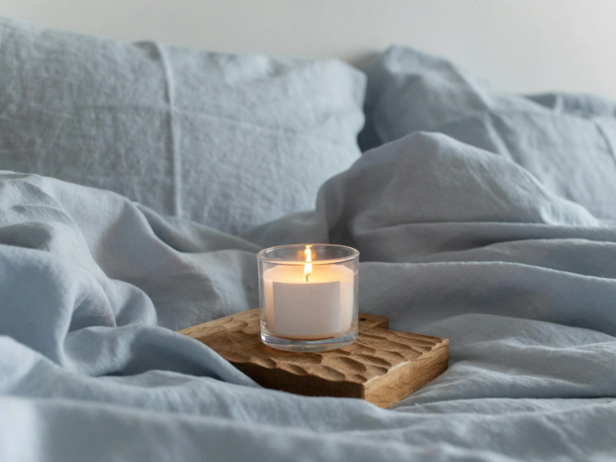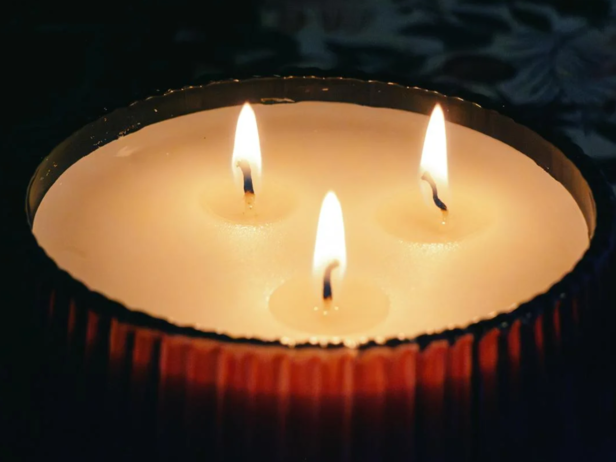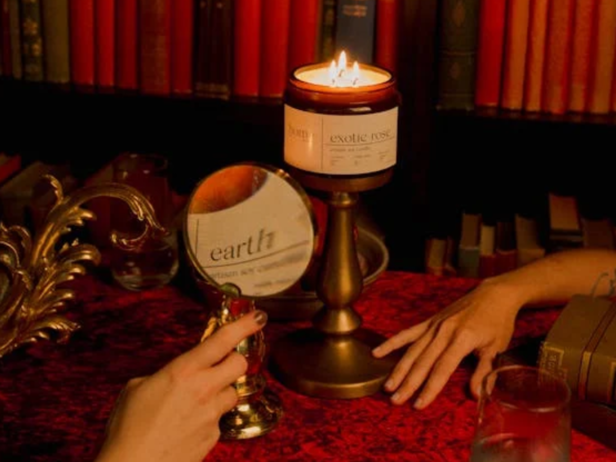Love Scented Candles? Beware Of It's Hidden Dangers
Gurjeet Kaur | Apr 12, 2025, 23:10 IST
Candles
( Image credit : Times Life Bureau )
Love scented candles? Their cozy glow hides a dark secret! Toxic chemicals in synthetic fragrances can pollute your air, trigger allergies, or worse—harm your health. From benzene to phthalates, the risks are real. Don’t let your favorite ambiance silently poison you. Discover the shocking dangers and learn how to stay safe with every flicker!
We all love Scented candles. we lighting up homes with warm glows and inviting smells like vanilla, lavender, or pumpkin spice. They’re perfect for relaxing baths, romantic dinners, or just making your space feel special. But here’s the catch: those flickering flames and sweet scents might be hiding some serious health risks. From toxic chemicals to indoor air pollution, scented candles could be doing more harm than good. This article dives into the surprising dangers of scented candles, explains how they affect your body, and shares simple ways to stay safe while still enjoying that candlelit vibe. Let’s uncover the truth and keep your home healthy!

To understand the risks, let’s break down what scented candles are made of. Most candles have three main parts— Wax, Wick and Fragrance. Wax is Usually paraffin (made from petroleum), soy, or beeswax. Wick is the string that burns to keep the flame going. Fragrance is Oils or synthetic scents that give candles their smell. When you light a candle, the wax melts, the wick burns, and the fragrance fills the air. Sounds harmless, right? But the way these parts are made and burned can release stuff that’s not so great for your health. Let’s dig into the dangers.

Beneath their flickering charm lies a troubling reality: potential health risks that often go unnoticed. The synthetic fragrances and wicks in many candles release harmful chemicals like benzene, toluene, and phthalates into the air, silently polluting your indoor environment. These toxins can trigger respiratory issues, allergies, or even long-term health concerns with prolonged exposure. Paraffin wax, commonly used in budget-friendly candles, emits soot and carcinogens when burned, further compromising air quality. While the allure of a cozy evening with a scented candle is undeniable, the hidden dangers demand attention.
Most cheap scented candles use paraffin wax, which comes from crude oil. When burned, paraffin releases harmful chemicals like benzene and toluene—both linked to cancer and neurological damage. These toxins float into the air you breathe, especially in small, poorly ventilated rooms. Over time, breathing them in can irritate your lungs or worse. Studies, like one from the Environmental Protection Agency (EPA), show paraffin candles produce more harmful particles than cleaner waxes like soy or beeswax.
Ever notice black dust around your candle jar or on nearby walls? That’s soot—tiny particles released when candles burn incompletely. Scented candles, especially those with synthetic fragrances, create more soot than unscented ones. Soot can get deep into your lungs, causing breathing problems like asthma or bronchitis. In tight spaces, it’s like inviting smog into your living room. A 2009 study in Atmospheric Environment found that burning candles indoors can spike air pollution levels, rivaling car exhaust in some cases.
That “ocean breeze” or “cinnamon apple” scent? It’s often made from synthetic chemicals, including phthalates, which can mess with hormones and trigger allergies. Breathing in these fragrances can cause sneezing, itchy eyes, headaches, or even skin rashes for sensitive folks. People with asthma or chemical sensitivities might feel worse, with symptoms like wheezing or tightness in the chest. The more candles you burn, the more these chemicals build up in your air.
Some older or low-quality candles use wicks with metal cores, sometimes containing lead. Burning these releases lead particles into the air, which is toxic, especially for kids and pregnant women. Lead can harm brain development and cause issues like learning difficulties or behavioral problems. While lead wicks are banned in many countries (like the U.S. since 2003), cheap imports might still slip through. Always check for “lead-free” labels to stay safe.
Beyond air quality, candles can be a fire hazard. A forgotten candle can ignite curtains, furniture, or pets’ fur. The National Fire Protection Association reports that candles cause about 7,600 house fires yearly in the U.S., leading to injuries and property damage. Burns from hot wax are another risk, especially if you knock over a candle or touch the flame. These dangers aren’t unique to scented candles, but their popularity means more people are lighting them without thinking twice.

Burning a scented candle now and then might not seem like a big deal, but regular use can add up. Here’s how the risks hit your health:
Soot and chemicals irritate airways, making it harder to breathe. If you have asthma or allergies, candles can trigger attacks or worsen symptoms. Toluene and benzene can cause headaches, dizziness, or fatigue. Long-term exposure might even affect memory or mood.
Phthalates in fragrances can disrupt hormones, potentially affecting fertility or metabolism over time. Fragrance chemicals can cause redness, itching, or watery eyes, especially if you’re sensitive. Kids, pets, and people with health conditions are extra vulnerable. A small room with a burning candle is like a tiny pollution bubble—everyone inside is breathing the same bad air.

Despite the risks, scented candles are everywhere. Why? Because they’re affordable, easy to find, and make any space feel cozy or luxurious. They’re marketed as stress-relievers—light a lavender candle, and poof, you’re relaxed (or so the ads say). Social media doesn’t help, with influencers showing off candlelit vibes that make you want to stock up. But the truth is, those warm fuzzies come with a hidden cost. Knowing the dangers lets you enjoy candles smarter, not ditch them entirely.

If you feel headaches, coughing, or dizziness after burning candles, it might be a sign of sensitivity. Stop using them and air out your space. If symptoms stick around, see a doctor—they could check for allergies or lung irritation. Pets acting sluggish or sneezing near candles might also need a vet visit.
Scented candles bring warmth and charm, but their hidden health risks—like toxic chemicals, air pollution, and fire hazards—are real. From lung irritation to hormone disruption, the dangers sneak into your home with every flicker. But you can still enjoy that cozy vibe by choosing natural waxes, ventilating your space, or trying flameless options. Your health deserves a breath of fresh air, not a cloud of candle soot. Next time you light up, make smart choices and keep the glow safe. Here’s to a healthier, happier home.
Explore the latest trends and tips in Health & Fitness, Travel, Life Hacks, Fashion & Beauty, and Relationships at Times Life!
1. What’s in a Scented Candle?

Candle
( Image credit : Pexels )
To understand the risks, let’s break down what scented candles are made of. Most candles have three main parts— Wax, Wick and Fragrance. Wax is Usually paraffin (made from petroleum), soy, or beeswax. Wick is the string that burns to keep the flame going. Fragrance is Oils or synthetic scents that give candles their smell. When you light a candle, the wax melts, the wick burns, and the fragrance fills the air. Sounds harmless, right? But the way these parts are made and burned can release stuff that’s not so great for your health. Let’s dig into the dangers.
2. Health Risks of Scented Candles

Candle Light
( Image credit : Pexels )
Beneath their flickering charm lies a troubling reality: potential health risks that often go unnoticed. The synthetic fragrances and wicks in many candles release harmful chemicals like benzene, toluene, and phthalates into the air, silently polluting your indoor environment. These toxins can trigger respiratory issues, allergies, or even long-term health concerns with prolonged exposure. Paraffin wax, commonly used in budget-friendly candles, emits soot and carcinogens when burned, further compromising air quality. While the allure of a cozy evening with a scented candle is undeniable, the hidden dangers demand attention.
Toxic Chemicals from Paraffin Wax
Soot and Indoor Air Pollution
Synthetic Fragrances and Allergies
Lead and Metal Wicks
Fire and Burn Risks
3. How Scented Candles Affect Body

Candle Fragrance
( Image credit : Pexels )
Burning a scented candle now and then might not seem like a big deal, but regular use can add up. Here’s how the risks hit your health:
Soot and chemicals irritate airways, making it harder to breathe. If you have asthma or allergies, candles can trigger attacks or worsen symptoms. Toluene and benzene can cause headaches, dizziness, or fatigue. Long-term exposure might even affect memory or mood.
Phthalates in fragrances can disrupt hormones, potentially affecting fertility or metabolism over time. Fragrance chemicals can cause redness, itching, or watery eyes, especially if you’re sensitive. Kids, pets, and people with health conditions are extra vulnerable. A small room with a burning candle is like a tiny pollution bubble—everyone inside is breathing the same bad air.
4. Why Are Scented Candles So Popular?

Candles for Decoration
( Image credit : Pexels )
Despite the risks, scented candles are everywhere. Why? Because they’re affordable, easy to find, and make any space feel cozy or luxurious. They’re marketed as stress-relievers—light a lavender candle, and poof, you’re relaxed (or so the ads say). Social media doesn’t help, with influencers showing off candlelit vibes that make you want to stock up. But the truth is, those warm fuzzies come with a hidden cost. Knowing the dangers lets you enjoy candles smarter, not ditch them entirely.
5. Safe Ways to Enjoy Candles Without the Risks

Red Candle
( Image credit : Pexels )
- Swap paraffin for soy, beeswax, or coconut wax. These burn cleaner, releasing fewer toxins. Look for labels saying “100% natural” or “paraffin-free.” Bonus: they often last longer, so you get more glow for your buck.
- Pick candles with cotton or wood wicks labeled “lead-free.” Trim the wick to ¼ inch before lighting to reduce soot and keep the flame steady. A shorter wick means a cleaner burn.
- Opt for candles scented with essential oils instead of synthetic fragrances. Lavender, eucalyptus, or citrus oils smell great and are less likely to trigger allergies. Avoid candles with vague “fragrance” labels—those often hide chemicals.
- Crack a window or turn on a fan when burning candles. Good airflow cuts down on soot and chemical buildup. Don’t burn candles in tiny, closed rooms like bathrooms for too long—it traps pollutants.
- Burn candles for 1–2 hours max, then give your air a break. Blow them out if you’re leaving the room or going to sleep. This reduces exposure and fire risks. Use a snuffer to avoid smoky smells.
- Love the ambiance but hate the risks? Try LED candles for a flameless glow or diffusers with essential oils for scent without smoke. Wax warmers melt scented wax without burning, cutting down on soot.
When to Worry
Scented candles bring warmth and charm, but their hidden health risks—like toxic chemicals, air pollution, and fire hazards—are real. From lung irritation to hormone disruption, the dangers sneak into your home with every flicker. But you can still enjoy that cozy vibe by choosing natural waxes, ventilating your space, or trying flameless options. Your health deserves a breath of fresh air, not a cloud of candle soot. Next time you light up, make smart choices and keep the glow safe. Here’s to a healthier, happier home.
Explore the latest trends and tips in Health & Fitness, Travel, Life Hacks, Fashion & Beauty, and Relationships at Times Life!
